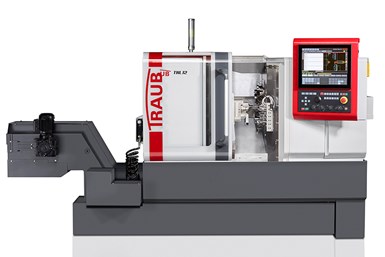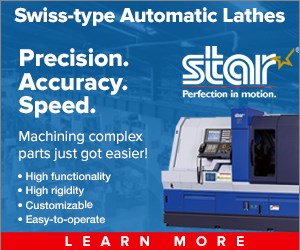Index Corp.’s Sliding Headstock CNC Lathe for Small Parts Machining
The frontworking attachment and counterspindle are now housed on separate slides, which is said to eliminate potential interdependence between front-end and counter-spindle machining, enabling greater programming flexibility.

Index Corp.’s Traub TNL12 sliding headstock lathe. Photo Credit: Index Corp.
Index Corp.’s Traub TNL12 sliding headstock lathe for small part machining features a variety of design changes to boost speed, flexibility and accuracy. The machine is said to be well suited for medical manufacturers responsible for producing implants, bone screws and instruments for minimally invasive surgery.
Like its predecessor, the TNL12 features four tool carriers that can be applied to a workpiece simultaneously. While the frontworking attachment and counterspindle were previously arranged on a single slide, they are now housed on separate slides. This is said to eliminate potential interdependence between front-end and counter-spindle machining, enabling greater programming flexibility. The design is also said to reduce the mass of both elements, enabling faster and more dynamic machine response.
While the former model of the machine offered X-axis machining on the counterspindle, the latest TNL12 provides full 3-axis machining in this position. A new backworking attachment offers six tool stations, with up to four enabling live tooling, as well as a flushing unit.
Overall tooling capacity has also been increased, with the capability to house up to 40 tools with the use of double and triple holders. This is said to give operators more freedom to optimize machining of highly complex parts. Each of two 6-station tool turrets has its own servomotor and interpolated Y axis, with chip-to-chip tool change times reduced to 0.3 second, the company says.
While the previous generation TNL12 used belt drives on the main and counterspindles, the new machine incorporates fluid-cooled motor spindles with a maximum speed of 12,000 rpm. It is also said to offer higher dynamic response because of low-mass clamping cylinders and a carbon sleeve for the guide bushing drive. The guide bushing is freely selectable, live or programmable, with the ability to adjust itself via a pneumatic servo valve.
Related Content
-
Does a Scanning Probe Make Sense on a Swiss-Type?
Swiss-types have limited tooling capacity, but there can be advantages to giving up some of that capacity to take advantage of a touch probe — in fact, a scanning probe — to enable in-process part measurements.
-
Choosing the Right Machine for Turned and Milled Medical Parts
The medical market is known for exceptionally tight tolerances and difficult materials, which means that selecting the proper machine is necessary to ensure a job is profitable.
-
Shop Optimizes its Swiss-Turning Flexibility
Paramount Machine uses various Swiss-type lathes, some with a B axis, to produce parts more effectively than it did on conventional chucker lathes. Today, nearly every job under 1.5 inches in diameter runs across those machines even if the batch size is a mere 5 pieces.
















